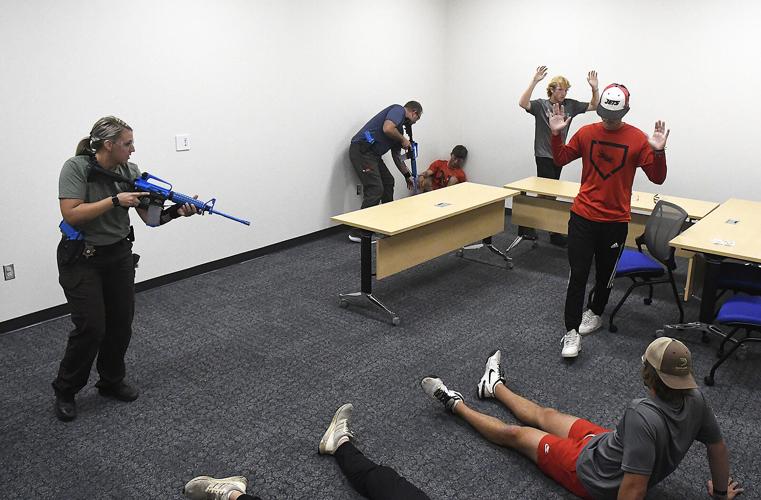Just how to Prepare Your Team with Active Shooter Training for Emergency Situations
Wiki Article
The Necessary Function of Active Shooter Training in Enhancing Emergency Feedback Methods in Different Environments
Active shooter training has emerged as a basic element in refining emergency feedback methods across varied settings, from academic institutions to company environments. The performance of such training hinges on numerous elements, consisting of the specific context in which it is executed and the recurring commitment to enhancement.Value of Energetic Shooter Training
In an age marked by enhancing worries over public safety, the value of active shooter training can not be overemphasized. As events of weapon physical violence in public areas remain to rise, organizations across various sectorsâEUR" schools, work environments, and public venuesâEUR" are acknowledging the requirement of preparing their employees and areas for such emergency situations. Energetic shooter training furnishes people with crucial skills and knowledge to respond efficiently in dangerous circumstances, potentially reducing casualties and saving lives.The training not only concentrates on immediate response actions, such as evacuation and sheltering in position, but additionally cultivates a society of understanding and preparedness. By taking part in sensible simulations and conversations, participants can identify possible susceptabilities within their atmosphere and develop strategies for mitigating threats. Such training enhances interaction and sychronisation among group members and first -responders, guaranteeing a more unified strategy throughout dilemmas.

Key Parts of Effective Educating
Effective active shooter training consists of several essential parts that enhance preparedness and feedback capabilities. Most importantly, reasonable scenario-based simulations are crucial. These exercises submerse participants in high-stress circumstances that mimic prospective active shooter occasions, permitting them to practice decision-making and physical feedbacks under pressure.Furthermore, training must include a thorough understanding of communication protocols. Participants must be fluent in exactly how to relay critical details to police and fellow people throughout an occurrence. This includes using emergency informs and recognizing the pecking order.
An additional crucial part is the unification of psychological wellness recognition. Training must attend to the mental effect of active shooter situations, equipping participants with dealing approaches and sources to support their mental well-being post-incident.
Furthermore, regular correspondence course are essential to make certain that abilities stay sharp and understanding is updated. This constant education strengthens the value of preparedness and cultivates a society of security within organizations.
Training for Various Atmospheres
Active shooter training must be customized to the certain environments in which people run, as each setting presents one-of-a-kind difficulties and dynamics. For example, training in a company office will vary dramatically from that in an institution, shopping center, or medical care center. Each atmosphere necessitates a tailored method that considers variables such as design, population thickness, and available retreat paths.In instructional establishments, training programs ought additional info to stress lockdown treatments, communication protocols with regulation enforcement, and methods for safeguarding trainees. Alternatively, in business setups, training may concentrate on emptying strategies, identifying questionable behaviors, and making use of offered resources for protection or shelter-in-place scenarios.
Moreover, public places like shopping centers or sporting occasions need extensive crowd monitoring techniques, with a focus on rapid feedback control among safety and security workers and neighborhood police.
In health care settings, training must deal with certain susceptabilities, such as the visibility of people who may require instant aid. By recognizing the distinct attributes of each setting, companies can develop effective training components that enhance readiness and improve total safety, guaranteeing that individuals are equipped to react suitably in diverse dilemma scenarios.

Building a Culture of Awareness
Creating a society of understanding is essential to enhancing safety actions in any type of atmosphere, as it empowers people to acknowledge potential threats and react proactively. This culture demands constant education, open interaction, and the assimilation of security methods right into daily regimens.Organizations must focus on active shooter training as component of their overarching safety approach, ensuring that all workers recognize the More Help particular threats associated with their setting. Regular training sessions cultivate alertness and familiarity with emergency treatments, encouraging individuals to stay sharp to unusual habits or conditions.
Furthermore, cultivating a society of awareness includes developing an environment where reporting questionable task is both urged and normalized. active shooter training. Employees need to really feel comfy sharing their concerns without worry of revenge. This can be achieved through clear channels of interaction and encouraging management
Additionally, taking part in neighborhood collaborations can enhance awareness beyond organizational borders, advertising a common obligation for security. Campaigns such as workshops, drills, and informative sessions can additionally boost collective watchfulness. Eventually, developing a society of recognition not just prepares people for potential dilemmas yet additionally strengthens the general strength of the company versus hazards.
Evaluating Training Effectiveness
While regular training sessions are important for readiness, examining their efficiency is just as important to guarantee that workers are geared up with the needed abilities and expertise to react properly in case of an active shooter scenario. Examination procedures need to consist of both qualitative and measurable assessments to determine the effect of training on reaction capabilities.Surveys and responses from individuals can click reference give beneficial understandings into the training's relevance and applicability. Additionally, carrying out useful drills and simulations enables companies to observe real-time decision-making and synergy under stress. Assessing the results of these exercises assists recognize staminas and locations for enhancement.

Including stakeholders, consisting of law enforcement and emergency situation -responders, in the evaluation process can improve reputation and provide a detailed viewpoint on training efficiency (active shooter training). Inevitably, an organized analysis technique makes certain that energetic shooter training continues to be an important part of a company's emergency action approach, promoting a more secure setting for all
Conclusion
Active shooter training is essential in strengthening emergency situation response strategies throughout diverse environments. Inevitably, the execution and examination of effective training programs add dramatically to alleviating the impact of active shooter scenarios, consequently safeguarding lives and boosting neighborhood resilience.Report this wiki page